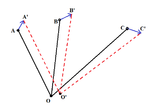DanDo
Newbie level 3
My problem is: I have a set of 4 points O, A, B, C locating on a surface. Due to distortion of that surface, A, B, C are moved to new positions which are A', B', C'. Now I want to find new position of O (supposed O') satisfying root mean square error (RMSE) of two set of distances (O'A', O'B', O'C', OO') and (OA, OB, OC, OO) is minimal. So dose anyone know which algorithm can solve my problem?

